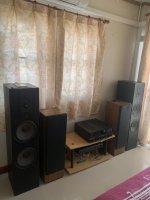I own a pair of ADS L1590/2 and I’m delighted with them, although they have some fault designs.
As you can read the review on this link: https://www.audioasylum.com/reviews/Speakers/ADS/L1590-2/speakers/32/322122.html. I couldn’t agree more with the reviewer that we found “the cabinets exhibited a lot of talk”. There were a lot of “Ummm” sound on the male voice and some blur on the instrument.
Anyway, I had built a diy pair that copied the L1590/2s dimension since I was fascinated with their appearances. The cabinet of this diy pair had identical external dimension to preserve the L1590/2s look. But, the thickness of the MDF was only 16 mm. while the original has 19 mm. (same MDF). And all bracings inside the cabinets were the same pattern as the original.
BUT, the result was different. There were no cabinet talks on my diy pair at all!
Could anyone please explain why I didn’t find a cabinet talk on my replica despite the fact that they had the same dimensions, and also had thinner cabinet wall?
About the woofers in the replica, they were car subwoofers where ADS fans called them the 4-Ohm version of those in the L1590/2. Low-pass crossover is crossed at about 700 Hz, whereas the L1590/2s is about 350 Hz.
As you can read the review on this link: https://www.audioasylum.com/reviews/Speakers/ADS/L1590-2/speakers/32/322122.html. I couldn’t agree more with the reviewer that we found “the cabinets exhibited a lot of talk”. There were a lot of “Ummm” sound on the male voice and some blur on the instrument.
Anyway, I had built a diy pair that copied the L1590/2s dimension since I was fascinated with their appearances. The cabinet of this diy pair had identical external dimension to preserve the L1590/2s look. But, the thickness of the MDF was only 16 mm. while the original has 19 mm. (same MDF). And all bracings inside the cabinets were the same pattern as the original.
BUT, the result was different. There were no cabinet talks on my diy pair at all!
Could anyone please explain why I didn’t find a cabinet talk on my replica despite the fact that they had the same dimensions, and also had thinner cabinet wall?
About the woofers in the replica, they were car subwoofers where ADS fans called them the 4-Ohm version of those in the L1590/2. Low-pass crossover is crossed at about 700 Hz, whereas the L1590/2s is about 350 Hz.
Attachments
Dunno beyond the fact that all else equal, the thinner panel resonates at a higher frequency with the same bracing raising it even higher, ergo lower amplitude/faster decay, especially with the XO 2x higher whereas at 350 Hz with thicker panels the cab's strong LF resonances are 'locked in' so to speak where the male's voice, many instrument's lower BWs reside. Maybe the originals just needed some well matched isolation feet to absorb them. Can't rule out differences in the woofers either.

